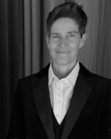Kristen Wolf's Blog: www.wonderchews.com
January 31, 2021
A New Word
Do you know what a group of penguins in the water is called?
Brace yourself…

A raft.
Right?!?
Do you know what a group of penguins on land is called?
I almost can’t take it…

A waddle.
I can’t even write it and not smile.
To learn more about these amazing creatures who fly, literally, through the air go HERE.
top photo credit: Ann and Steve Toon Wildlife Photography
bottom photo credit: Kevin Schafer
The post A New Word appeared first on Wonderchews.
January 17, 2021
What We Have in Common

Given the amount of suffering being experienced the world over, it seems wrong to consider any possible benefit that might arise from the pandemic. That said, hope is the only antidote I know for despair. And it’s in the spirit of hope – and a prayer – that I offer this possibility.
Have you ever exited from a movie or play and felt a rush of connection with those crowded around you?
Have you ever broken the ice with a complete stranger by discussing a book you’d both read? Or a TV show you both watched?
Have you ever been victim to a large scale disaster such as a wildfire, an attack, or a flood and found yourself consoling (or being consoled by) someone you’ve never met?
I’ve experienced all of the above and can attest that for better or worse, the sharing of a common experience or pain can draw together even the most disparate of people and encourage everlasting bonds between them.
As I watch young people around the globe suffer the calamity that is the pandemic, I can’t help but imagine how this shared experience – and the recalling of it – might serve as a bond that unites them in the future.
Just imagine people traveling to different countries after this. For the first time in history, everyone – ever single person – will have had their life altered – at the exact same time by the exact same event.
Could the future recalling of this shared cataclysm act like glue to draw people together as never before?
Though everyone’s experiences will differ in the details, they’ll all share that one simultaneous source.
I can’t help but wonder how this commonality, this ubiquitously shared event might wield the power to bridge differences in the future.
I’ll admit, the idea sounds wildly optimistic. But given our current position, lodged firmly in the darkest hour, it feels necessary to at least consider hope.
Photo Credit: Kalyan Varma
The post What We Have in Common appeared first on Wonderchews.
January 9, 2021
Where We Are

A friend sent me this image recently.
The sculpture was built for the Burning Man festival in 2015 by Ukrainian artist Alexander Milov.
The sculpture, entitled “Love,” was meant as an expression of our inner and outer selves. Particularly how our adult bodies can overshadow our inner children.
However the dilemma it captures strikes a different chord in me during these current (pandemic) times and seems prescient in a way the artist couldn’t have foreseen.
I wonder how many of us are feeling — or have felt, or will feel — the distinctive brand of isolation captured here?
Photo source: Oleg Yarov
The post Where We Are appeared first on Wonderchews.
May 6, 2016
Funny for Friday 5/6
Learn more about British cartoonist Tom Gauld.
The post Funny for Friday 5/6 appeared first on Wonderchews.
May 1, 2016
This Dewdrop World
What happens to tears when they dry up?
What is left?
That’s what Dutch photographer Maurice Mikkers wanted to find out.
For his series, Imaginarium of Tears, he had friends and family come over and cry their eyes out, literally — while cutting onions, recalling old sorrows, laughing etc. He then carefully collected the various tears and set them to dry on microscope slides.
Because each tear contains varying amounts of antibodies, oils, salts, enzymes etc. suspended in water, no two are alike. And therefore no two will crystallize into the same pattern.
When Mikkers backlit and magnified his catch, he discovered a world of unimaginable beauty.
Part snowflake, part cosmos.
And who knows? Perhaps one day we’ll discover that the only difference between such phenomena lies in scale and materials. Not in essence. Not in the force that drives their design.
And in that sense, one can serve as a map for the other.
In the words of the Japanese poet:
This dewdrop world
is but a dewdrop world,
and yet —
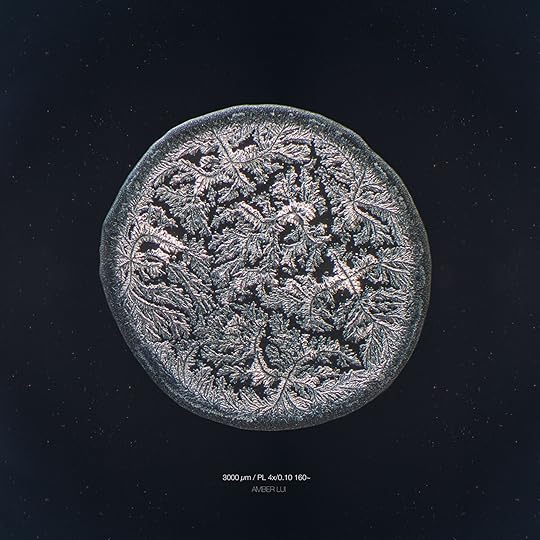
All photos by Maurice Mikkers
The post This Dewdrop World appeared first on Wonderchews.
February 12, 2016
Funny for Friday
To see more of Tim Whyatt’s work go here.
To experience metamorphosis go here.
The post Funny for Friday appeared first on Wonderchews.
February 8, 2016
Bodies of Light
This post was inspired by my son who’s recently become fascinated with dinoflagellates and said I should write something about them.
No, dinoflagellates are not dinosaurs.
They’re protists, single-celled creatures such as marine plankton.
And though small, they possess the amazing power of bioluminescence — meaning, they can glow. In their case, it is whenever they are disturbed (by predators or currents) that they flare.
When their numbers are high enough, they can make ocean waves come alight.
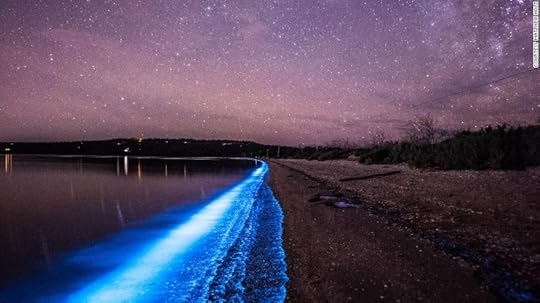
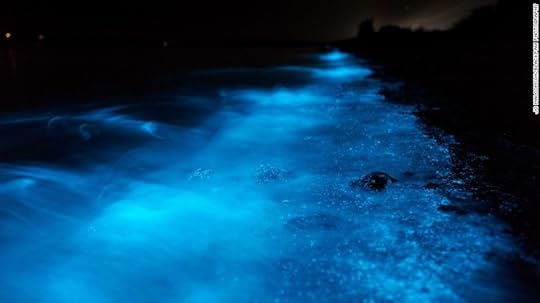
The phenomenon of bioluminescence — its chemistry and the many creatures in which it occurs — is endlessly fascinating and its discussion could fill thousands of pages. If you are keen to learn more about it, you can read a great article from National Geographic here. The American Museum of Natural History also features a lot of fun, interactive information here.
But since Wonderchews isn’t so much about describing wonders as contemplating the deeper meaning and connections behind them, I wanted to find something about dinoflagellates that would give pause for further thought and (can’t resist) enlightenment.
After a bit of research I came across a sample of some amazing footage taken by ORCA – The Ocean Research & Conservation Association. It shows a cluster of barnacles feeding on bioluminescent dinoflagellates as they float by. When the barnacles strike their prey, the turbulence they create triggers the dinoflagellates’ bioluminescence. As a result of the effect, the barnacle animals appear to be eating mouthfuls of light!
This struck me as significant.
Because what it made me re-remember is that every living thing — every single organism that consumes food of one kind or another for life — is, in fact, eating mouthfuls of light.
In our case, that light may come in the form of a hamburger or sushi or broccoli — but these items and all others are merely energy transmuted into different substances, all of which share the common ancestry of sunlight. And it is the miraculous and mind-boggling process of photosynthesis, of transforming sunlight into energy on the physical plane, that both initiates the variety of life and underpins it. Every day, the sun’s light travels millions of miles to Earth and is absorbed, say, by photosynthetic algae which in turn are consumed and transformed (by adding water and various elements) into shrimp which are consumed and transformed into fish which are consumed and transformed into human bodies — you can follow this trail of nourishment for any creature — and if you follow the path backward far enough, you will always find yourself steeped in light.
(There is, of course, the recent and fascinating discovery of electron-eating bacteria — but even here the case could be made that the creatures are consuming a shape-shifted version of light.)
So remember — You Are What You Eat.
photo credits: Aqueros and Matthew Holz and JD Malcolm/Blackpaw Photography
The post Bodies of Light appeared first on Wonderchews.
January 30, 2016
Passage from Work-in-Progress
I look in the mirror. See someone reflected. I believe it is me yet have no proof.
And worse, I am not certain of who “me” might even be.
Having become aware that I do not possess a certainty of self as others do has caused me a great deal of pain. Not a defined pain. Not the cut of knife or the break of heart, but a wide, shapeless pain. Without clear origin or ending. An overwhelming ache, everywhere at once.
There are days when I feel that I must succumb. That I can’t go on.
How can I continue to live when there is no being to call my own. No whole that I recognize. No name that fits.
And how, you ask, have I come to this despair?
I assume it is because the sense of self that others develop slowly over time, through the sensations of living, was denied me. In my youth there was no experience of trial and error, loss and gain, the testing of boundaries and limits, moving against and along emotions that arise from the body, the slow shaping of beliefs and values. This dilemma resulted from the fact that most of what is “me” was placed inside my person by others. The beat of me set already to their march. So that I never had the chance to induce and carve out a rhythm of my own.
What perhaps makes my situation more painful is that it is invisible to anyone but me. Technically, my hands are appended to my body and are therefore mine. Any objective observer would conclude the same. Yet they are not my hands. Not entirely. And I could say the same of my thoughts, fears and emotions. Even my breath.
I suppose, then, my destiny is not so much to discover who I am as to create who I am. To integrate the fragments that inhabit me, no matter their disparate origins and authors. To surround and claim them. To envelop them within a single membrane.
To embody, at last, my selves as One.
This is the challenge from which I cannot escape. Despite the agony. And unnatural curve.
The only question that remains:
Am I capable of this?
© 2016 Copyright Kristen Wolf. All rights reserved.
photo credit: LWS
The post Passage from Work-in-Progress appeared first on Wonderchews.
January 6, 2016
Wonder for the New Year
Everything… everything contains a pattern.
Whether it’s the algorithm behind the beating of a hummingbird’s wing, recurring DNA codes, fractals within crystals and clouds, or the mathematical framework of music, it would seem that nothing stands outside of intrinsic pattern.
That said, there are many phenomena such as chaos, dark matter, and the random dispersal of galaxies throughout space which, so far, seem to elude pattern — if not argue against it.
However, while enjoying several demonstrations of the pendulum wave effect (two of them are below) something occurred to me: in order to perceive a pattern, one must have a vantage that is above or beyond the phenomenon containing it. In other words, one could not perceive the repetition in a nautilus shell if one were an atom of calcium inside one of its swirls. Nor could one perceive the pattern in the beat of a hummingbird’s wing unless one’s sensory capabilities could process such speed (or slow the speed down in order to perceive it.)
Realizing this made the pendulum wave demonstrations all the more fascinating.
When you watch the examples below, you’ll see periods of striking symmetrical patterns that occur at certain intervals. In between these, however, are motions that appear more random.
Imagine, then, if you were to come upon and observe a system — whether a fiddlehead fern or a universe — during one of these seemingly chaotic intervals. This would make the overarching pattern nearly imperceptible. Then imagine further if the system operated in a timeframe of millions or billions of years — a super slow moving pendulum wave. This would make the overarching pattern even more invisible.
Would you not then conclude that the system (or phenomenon) that you were observing possessed no pattern whatsoever? Believing instead that it held only a collection of objects placed randomly and without any relation to one another?
This got me thinking:
What if we, and all that we’ve discovered so far, are contained within a pattern that is so vast and moving so slowly through a chaotic interval that we simply cannot perceive the grander and majestic pattern behind it?
What if we do exist within the equivalent of a pendulum wave, or the twisting spine of a helix, or the rhythmic vibration of a sonic wave?
Of course the patterns of which I’m speaking do not simply exist “out there.” We, ourselves, are patterns — complex amalgams of coordinated designs. And because we are patterns, we are born to seek, and long to find, the one far greater than ourselves from which we descended and/or of which we are a part — the mother pattern.
We can describe this vast pattern as god or the divine or the sacred source. We can even make assumptions and claim certainty of what lies beyond. But none of this hopeful mythologizing truly solves the mystery. And it is likely that we cannot yet imagine the vast shimmer of which we are a part.
In the meanwhile, claiming to know the details of what we could not yet possibly know will simply get us lost.
But wonder promises to draw us ever closer.
Video #1: This super haunting pendulum of light was set up by a truly gifted and respected science DIYer Brusspup.
Video #2: Though not as crisp as the above demonstration, this “life-size” pendulum wave really brings the effect home in a whole new and emotional way. On top of that, the larger size helps one imagine how much harder it would be to perceive patterns as the scale of the observed objects increase. Read more about its creator, Jeff Goodman, and how he built the pendulum.
Photo credit: Unknown
The post Wonder for the New Year appeared first on Wonderchews.
December 11, 2015
Artful Shifts
Art has so many hidden talents. One is certainly the ability to remind us of essential things we have forgotten.
I came across two stunning examples of this recently.
The first is the work of artist Darryl Cox wherein he grafts together ornate picture frames and gnarled tree branches from central Oregon. The result is a disorienting reminder that forms are both gained — and lost –through the artistic process. The work also provides a nod to the raw materials, often forgotten, that lie beneath our every day objects — and the fresh possibilities that arise if/when we recall them.

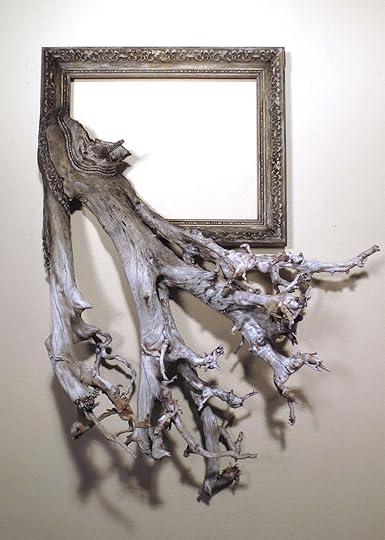
The second work I came across is that of Hillary Waters Fayle who stitches within and together the most delicate of cloth — that of botanical life.
Through the act of knitting seeds and embroidering leaves she allows us to see both intricacies in new ways. To consider how art and life are alike and how different. And to wonder if other ways might exist for them to cooperate. If nothing else, their visual beauty simply transports the imagination — another of Art’s hidden talents.
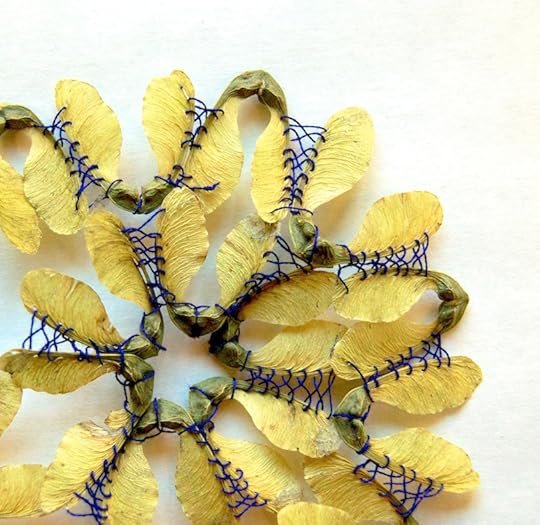
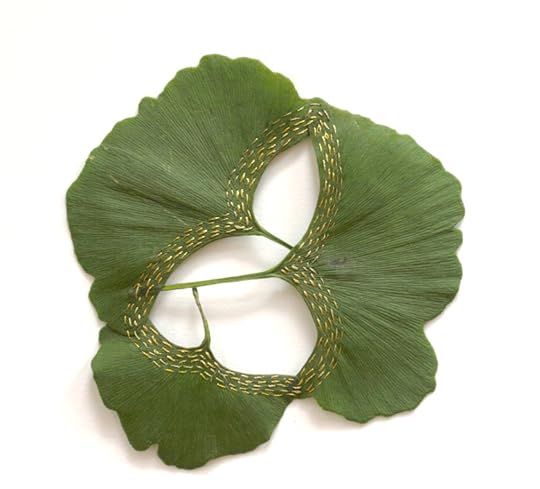
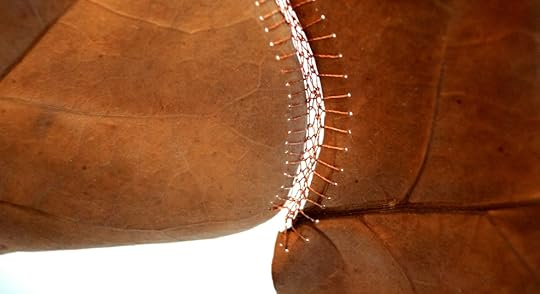
Photo credits: Darryl Cox and Hillary Fayle
The post Artful Shifts appeared first on Wonderchews.
www.wonderchews.com
- Kristen Wolf's profile
- 50 followers


